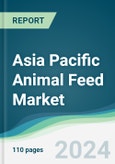The Asia Pacific animal feed market is evaluated at US$155.521 billion for the year 2022 growing at a CAGR of 6.16% reaching the market size of US$236.309 billion by the year 2029.
Rapid urbanization and rising disposable income in the region are expected to be the prime drivers behind this growth during the forecast period. In countries like India, the livestock population especially cattle, are associated with the rising human population, changing technology and growing meat industry in the region in the coming years. In addition, rising consumer health awareness is further expected to widen up growth opportunities for vendors and manufacturers in the region. According to a study by the FAO, it has been predicted that livestock production in the APAC region is expected to rise by 14% between 2021 and 2030. The development and growth of livestock production across the region are expected to lead to significant demand for highly nutritious animal feed products. The rise in the industrial production of beef, pork, mutton, and poultry overgrazing and mixed farming is projected to boost the demand for high-grade animal feed products in the Asia Pacific.Market Drivers
Growing focus on animal health and increase in the demand for organic meat to propel market growth.
Increased cattle farming is projected to drive demand for animal feed, due to the burgeoning demand for animal-based products by humans. Natural growth supporters are thus forecasted to be active in the market as their momentum grows further. Growing consumer awareness regarding the benefits of using feed additives to mitigate or even prevent harmful diseases has resulted in a shift from using standard animal feed to adopting functional and premium variants that would help improve enzootic disease immunity while also reducing the risk of metabolic disorders, injuries, acidosis, and infections. Furthermore, a rise in the demand for organic meat from consumers across various countries in the region, as well as the undertaking of new animal-rearing practices and the maintenance of high farming standards, has projected a positive outlook for the market in the region.Key Developments
- In October 2023: De Heus India announced to set up a new state-of-the-art production plant at Vividha Industrial Park, Punjab where the company would produce high-quality feed products that would bolster farm practices, The plant will be operational by 2025 and will produce 180 kMT (Kilo metric Tons) of animal feed.
- In April 2023: CH4 Global Inc. launched “Methane Tamer™ Beef Feedlot” which is a methane-reducing digestive aide feed formulation consisting of Asparagopsis seaweed. The new formulation will reduce methane emissions in cattle by 90% without negatively impacting their overall health and meat quality.
- In October 2021, BASF and Cargill announced a collaborative partnership in the animal nutrition business, augmenting R&D capabilities with new markets to the existing feed enzymes distribution agreements of the partners. This collaboration has aided in the creation, manufacturing, marketing, as well as sales of consumer-focused enzyme products, services and solutions for animals.
Segmentation:
By Type
- Fodder
- Forage
- Compound Feed
By Livestock
- Swine
- Aquatic Animals
- Cattle
- Poultry
- Others
By Raw Materials
- Soya
- Canola
- Rendered Meal
- Others
By Production Systems
- Integrated
- Commercial mills
By Distribution Channel
- Direct Selling
- Distributor
By Country
- China
- Japan
- India
- South Korea
- Australia
- Indonesia
- Vietnam
- Thailand
- Taiwan
- Others
Table of Contents
Companies Mentioned
- Cargill, Incorporated
- Kemin Industries, Inc.
- New Hope Liuhe Co., Ltd.,
- Archer-Daniels-Midland Company
- Weston Milling Animal Nutrition
- De Heus Beheer B.V.
- Tyson Foods Inc.
- Alltech Inc.
- East Hope Group
- Godrej Agrovet Limited
Methodology

LOADING...
Table Information
| Report Attribute | Details |
|---|---|
| No. of Pages | 110 |
| Published | February 2024 |
| Forecast Period | 2022 - 2029 |
| Estimated Market Value ( USD | $ 155.52 Billion |
| Forecasted Market Value ( USD | $ 236.31 Billion |
| Compound Annual Growth Rate | 6.1% |
| Regions Covered | Asia Pacific |
| No. of Companies Mentioned | 10 |









